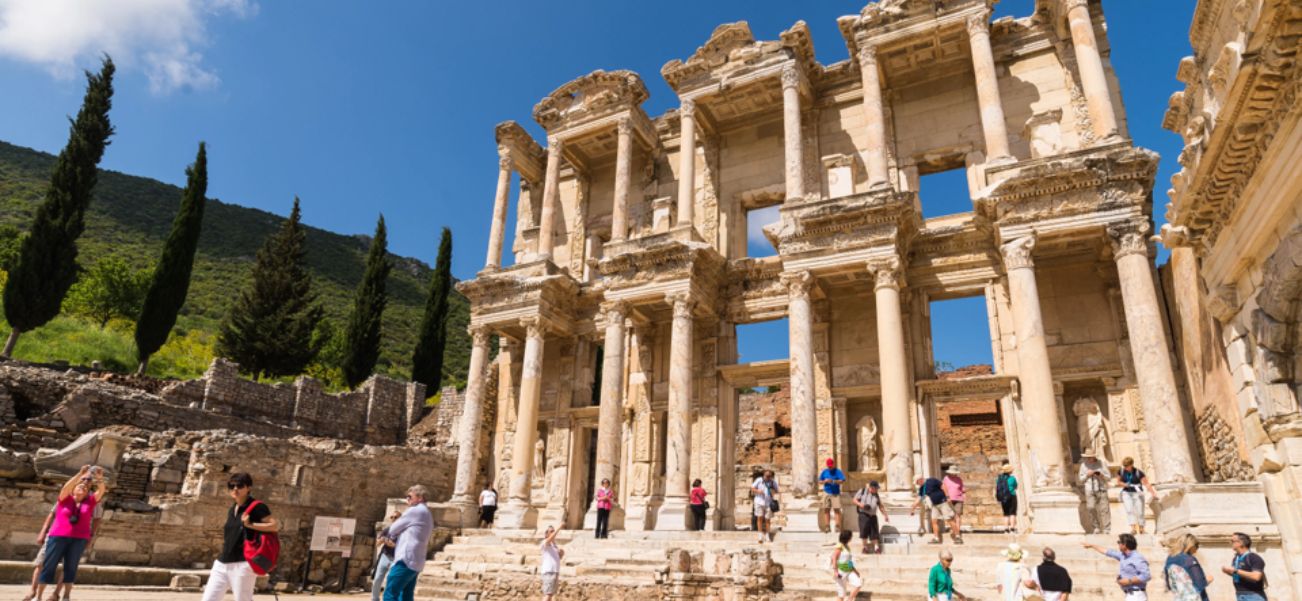
My Ephesus Story: Exploring Ephesus' Timeless Beauty
Walking along the marble streets of Ephesus, I felt as though I had stepped straight into the pages of history. This ancient city, once a thriving center of trade and culture, still stands with an elegance that takes your breath away. My journey led me to the magnificent Library of Celsus, its grand façade glowing under the Aegean sun, a reminder of the city’s intellectual and cultural wealth. I wandered into the Great Theater, imagining the roar of ancient crowds, and paused often to admire intricate ruins that have withstood centuries.
Ephesus is more than just a collection of stones—it’s a living story of civilizations past. In this travelogue, I’ll share my personal impressions, the fascinating history behind its most iconic landmarks, and the quiet moments where I simply stood still, absorbing the timeless beauty around me. Join me as I relive my unforgettable day in Ephesus.
My Ephesus Experience: Library of Celsus, Great Theater and More
Listen to my Ephesus travelogue in Izmir:
Exploring Ephesus: Walking Through Ancient Echoes

I’ve always loved ruins. Maybe it's the silence they hold, or the way crumbling stones still seem to speak. But nothing—not even Rome or Athens—prepared me for the overwhelming power of Ephesus.
This wasn't just an archaeological site—it was a city of whispers, of layers, of lives once lived. As I walked its marble roads under the warm Aegean sun, I wasn’t just sightseeing—I was time traveling.
Let me take you with me, back into a day I’ll never forget: the day I explored Ephesus, and walked through the echoes of the ancient world.
Arrival: Early Light Over an Ancient World

I arrived early. The kind of early that only birds and tour guides enjoy. The entrance gates had just opened, and only a few others trickled in behind me.
The sun had just risen, casting a soft golden light over the hills around Selçuk. The air was fresh and quiet, with only a gentle breeze rustling the leaves of olive trees nearby. There was a stillness I knew wouldn’t last—Ephesus is one of the most visited ancient sites in the world—but for now, I had it mostly to myself.
Walking the Marble Road: My Feet on History

The first steps into Ephesus felt surreal. I was walking on stones polished by thousands of years of footsteps—Romans, Greeks, Byzantines, traders, slaves, lovers, children.
I imagined sandals scraping across the marble, the sound of carts creaking, market vendors shouting in Greek or Latin. It was eerie, but exhilarating.
The road stretched ahead like a timeworn ribbon, flanked by columns and fractured statues. Every corner turned brought another surprise. A broken temple. A carved inscription. A tree growing out of stone.
This wasn’t a static museum. It was a city—frozen, but still breathing in its own way.
The Odeon: Whispers in a Tiny Theater

One of my first stops was the Odeon, a small theater built in the 2nd century AD. With seating for around 1,500 people, it was once used for poetry readings, concerts, and town meetings.
I sat down on one of the ancient stone benches, still surprisingly smooth, and imagined an evening performance under torchlight. I could almost hear the flicker of flames, the hum of anticipation, the soft voice of a harp echoing through the air.
It was in places like this that I felt closest to the past—not in reading plaques, but in pausing to feel what it might’ve been like to be there.
The Celsus Library: Stone That Still Inspires

Nothing prepared me for the moment I turned a corner and saw the Library of Celsus.
It was breathtaking.
Its grand façade stood tall against the clear blue sky—two stories of Corinthian columns, statues of wisdom and knowledge carved into alcoves, staircases worn by centuries. It looked like a film set, or something too perfect to be real. But it was real.
Built in 117 AD, the library once held over 12,000 scrolls. It was a monument not only to literature but to a man—Tiberius Julius Celsus Polemaeanus, a Roman governor buried beneath it.
I stood there for a long time. I traced my fingers along the ancient stone and read the Greek and Latin inscriptions still carved into its surfaces.
Even in ruin, it radiated intellect and ambition.
Terrace Houses: Glimpses of Roman Luxury

Behind the library, tucked under a massive protective roof, are the Terrace Houses—the private homes of Ephesus’ wealthy elite.
They were like Roman penthouses: multi-level residences with courtyards, mosaic floors, marble wall panels, and inlaid heating systems that still impressed two thousand years later.
I walked carefully on the suspended glass walkways, peering down into rooms where people once dined, debated, prayed. You could still see murals on the walls—scenes of mythology, family portraits, delicate floral patterns.
I remember pausing before a mosaic of a lion and feeling a strange closeness to the people who lived there. We weren’t that different. They loved beauty. They decorated their homes. They lived and hoped and aged. It was in those homes that Ephesus became personal.
The Great Theatre: Voices That Never Die

The path widened again, and suddenly I stood before the Great Theatre—a colossal, semi-circular structure that once held up to 25,000 people.
It was awe-inspiring. Towering stone tiers curved around a central stage, flanked by columns and carved backdrops.
This was more than just a performance space. It was the heart of public life. Gladiator battles, plays, political speeches. Even the Apostle Paul is said to have spoken here, facing a restless crowd in the very place where I now stood.
I climbed to the top row slowly, catching my breath and the view—rolling green hills, the marble road stretching below, and the Aegean Sea glittering in the distance.
I tried speaking—just a simple “Hello!”—and my voice carried across the whole theater like it was amplified by the stones themselves. I imagined an actor shouting lines from Sophocles. Or a crowd cheering. Or perhaps mourning.
The theater wasn’t silent. It just needed someone to listen.
The Harbor Road and the Lost Sea

From the theater, I walked down Harbor Street, once the main avenue that led directly to the sea. Today, the sea has retreated miles away due to sediment buildup from the river, but in ancient times, this was a bustling port road.
I closed my eyes and pictured it: merchant ships from Egypt or Athens docked nearby, sailors unloading amphorae of wine or oil, locals haggling over spices and silk.
Now it was just me, the rustle of trees, and the occasional chirp of cicadas. But in my mind, the noise of commerce echoed between the ruined colonnades.
A Moment of Stillness Among the Stones

By midday, the crowds had started to swell. Tour groups buzzed with guides and selfie sticks, and the magic of my early solitude began to fade. I found a shaded bench near the Temple of Hadrian, a beautifully preserved structure with curling stone reliefs of Medusa and mythological figures.
I sat there with a bottle of water and a small simit I’d packed. My feet ached. My mind was full.
I realized then that what moved me most about Ephesus wasn’t just the size of its monuments or the cleverness of Roman engineering. It was the intimacy.
This was a place where people had walked, fallen in love, prayed, bathed, read, and mourned. Ephesus didn’t just survive time—it held onto human stories.
Leaving Ephesus: Carrying the Past

I exited from the lower gate and looked back one last time. The library stood in the distance, proud and half-whole. The mountains beyond rolled gently, guarding the city like old friends.
As I left, I felt both heavy and light. I had walked through centuries. And though the stones stayed behind, a piece of Ephesus came with me.
What I Learned from Walking with the Ancients

Ephesus reminded me of something simple yet profound: History isn’t dead. It’s just quiet.
You don’t need to be a scholar to understand a place like Ephesus. You only need to listen—to the creak of old gates, the smoothness of worn stone, the silence between your footsteps.
And when you do, you’ll find that the ancients aren’t gone. They’re still there—watching, whispering, waiting.
Practical Tips for Visiting Ephesus

If you're planning your own journey through this ancient city, here’s what helped me:
- Go early or late: Beat the crowds and heat by arriving right when it opens or later in the day.
- Enter from the top gate: This lets you walk downhill through the site (easier on your legs).
- Bring water and snacks: There are no cafés inside the site.
- Don’t skip the Terrace Houses: It’s a small extra fee, but completely worth it.
- Hire a local guide or download an audio guide if you love history—it adds so much context.
Nearby, you can also visit:
- The House of the Virgin Mary: A pilgrimage site in the hills above Ephesus.
- St. John’s Basilica & Ayasuluk Fortress: In nearby Selçuk.
- Ephesus Archaeological Museum: Small, but full of stunning statues and relics.
Final Reflections: Echoes That Stay With You

That night, back in my small guesthouse in Selçuk, I lay in bed thinking about what I’d seen. My legs were tired, my camera full, my heart strangely full too.
Ephesus was more than a day trip. It was a reminder of continuity—of how people, despite the passing of millennia, are still driven by beauty, knowledge, community, and dreams.
I had walked through ancient echoes.
And they had spoken back.
Enjoy your trip to Ephesus!













